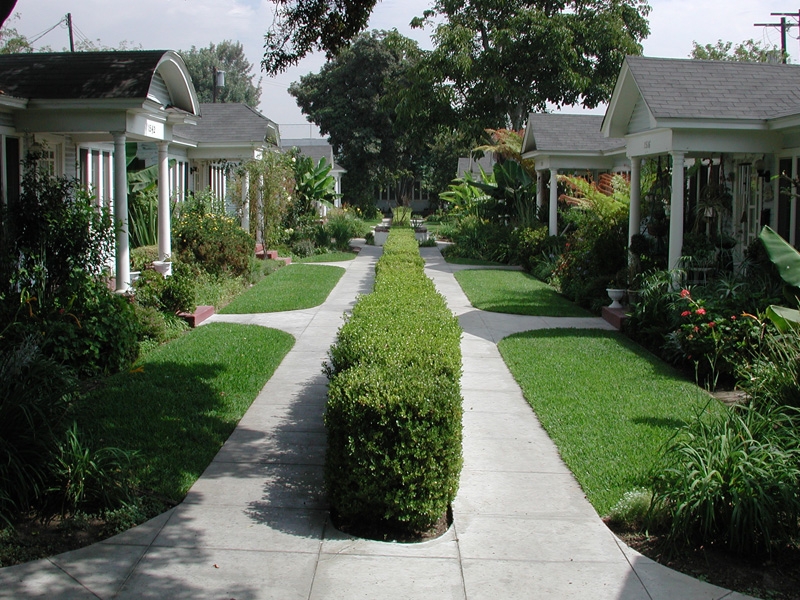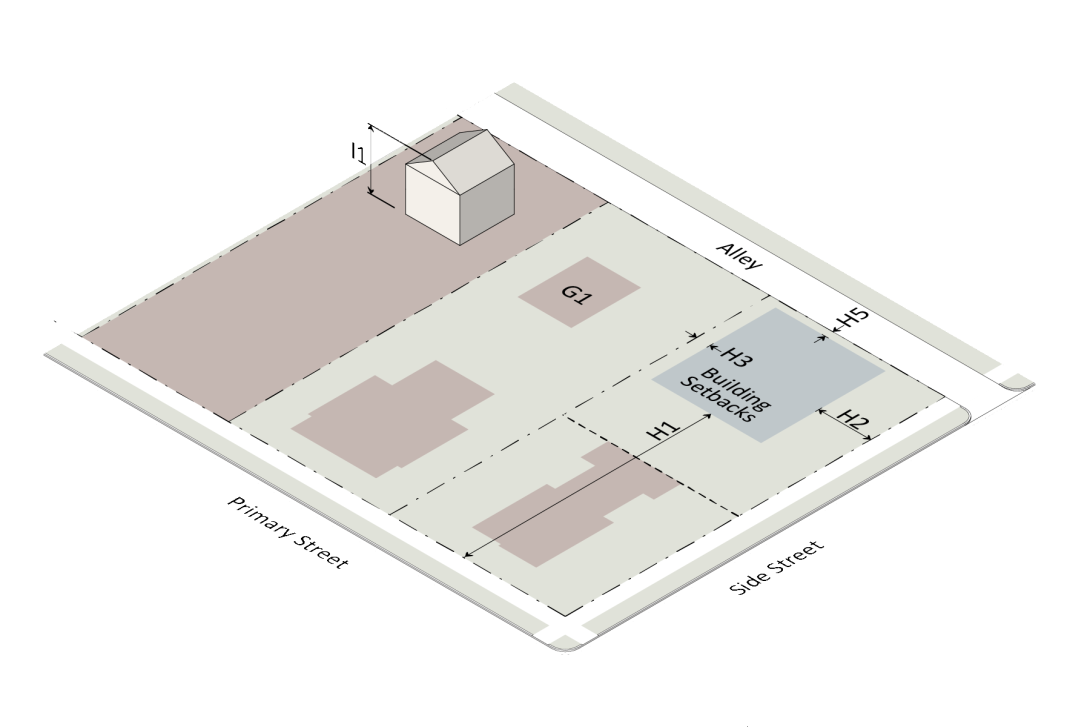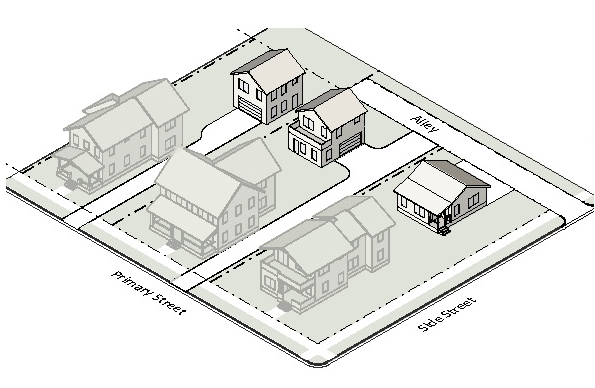
- Description
A cottage court is a group of small detached houses, attached houses, townhouses (two-unit maximum per building), or tiny houses sharing a common courtyard. The courtyard enhances the character of the area through the provision of consolidated open space. A cottage court may be developed on individual lots or with a common form of ownership. - Districts Allowed In
R-2, R-4, R-6, R-10 - Building Types Allowed
Detached house, attached house, townhouse (two-unit maximum per
building), tiny house Site and Lot Dimensions
R-2 R-4 R-6 R-10 D1 Net site area (min) 53,200 sf 26,600 sf 16,000 sf 13,000 sf D2 Site Width (min) 140' 140' 120' 90' D3 Site Depth (min) 120' 120' 100' 90' D4 Site area per non-Tiny House dwelling unit over four (min) 13,300 sf 6,650 sf 4,000 sf 2,650 sf D5 Site area per Tiny House dwelling unit over four (min) 10,000 sf 5,000 sf 3,000 sf 2,000 sf D6 Dwelling units per site (max) 30 30 30 30 D7 Dwelling unit conditioned space (max - excluding qualifying basements)1 1,800 sf 1,800 sf 1,800 sf 1,800 sf D8 Unconditioned space and accessory structure (individually and combined maximum per dwelling- excluding qualifying attics)2 500 sf 500 sf 500 sf 500 sf D9 Individual lot area (min) No min. No min. No min. No min. 1 A Tiny House may be no larger than 800 sf in building footprint and no more than 1200 sf in gross floor area. 2 A detached accessory structure must be less than the gross floor area of the principal dwelling. Internal Courtyard
R-2 R-4 R-6 R-10 E1 Area (min) 4,000 sf 3,250 sf 2,600 sf 2,100 sf E2 Width as measured parallel to primary street for first 15' of site depth (min)1 60' 50' 40' 30' E3 Courtyard area per non-Tiny House unit over four (min) 1,000 sf 850 sf 700 sf 550 sf E4 Courtyard area per Tiny House unit over four (min) 750 sf 425 sf 350 sf 225 sf E5 Setback from primary street (max) 0' 0' 0' 0' 1 No portion of the minimum internal courtyard area (E1) may be less than 20 feet in width and length. Principal Building/Structure Setbacks (Site)
R-2 R-4 R-6 R-10 F1 From primary street (min) 20' 20' 10' 10' F2 From side street (min) 15' 15' 10' 10' F3 From side site line (min) 10' 10' 10' 10' F4 From rear site line (min) 20' 20' 20' 20' F5 From alley (min) 5' 5' 5' 5' F6 Building separation (min) 6' 6' 6' 6' F7 From internal cottage court lot line (min) 3' 3' 3' 3' F8 From shared internal townhouse lot (min) 0' 0' 0' 0' Residential infill rules (Sec. 2.2.7) do not apply Surface Parking Setbacks
R-2 R-4 R-6 R-10 G1 From primary street if not screened from primary street by C3 yard or principal structure (min) 90' 90' 90' 90' G2 From primary street if screened from primary street by C3 yard or principal structure (min) 50' 50' 50' 50' G3 From side street (min) 10' 10' 10' 10' G4 From side lot line (min) 5' 5' 5' 5' G5 From rear lot line (min) 5' 5' 5' 5' G6 From alley (min) 0' 0' 0' 0' Parking setbacks shall not apply to driveways serving individual dwelling units or shared between two dwelling units. Height
R-2 R-4 R-6 R-10 H1 Non-Tiny House building height (max) 30' 30' 30' 30' H2 Tiny House building height (max) 26' 26' 26' 26' Residential Infill rules (Sec. 2.2.7) do not apply. - Courtyard Requirements and Restrictions
- At least 60% of the courtyard must be one contiguous open space.
- Courtyard may not be parked or driven upon.
- One common building (detached house building type) not to exceed 3,000 square feet in gross floor area may be permitted in the courtyard under the following conditions:
- The common building may not be used as a dwelling.
- Uses within the common building must be accessory to the cottage court development.
- The common building shall not count towards the maximum number of dwelling units per site (Sec. 2.6.1.D.6.)
- Notwithstanding the forgoing, the common building must comply with all other requirements of Section 2.6.1.
- Inclusive of the common building, up to 20% of the minimum internal courtyard area (Sec. 2.6.1.E.1.) may be covered, however only 10% of the minimum internal courtyard area (Sec. 2.6.1.E.1.) may be enclosed.
- Stormwater detention wet ponds and dry ponds shall not count towards the minimum internal courtyard area (Sec. 2.6.1.E.1.) Green Stormwater Infrastructure (GSI) practices may be used to meet up to 50% of the minimum internal courtyard area (Sec. 2.6.1.E.1.)
- Tree Conservation Areas shall not be included as part of the minimum internal courtyard area (Sec. 2.6.1.E.1.)
- Retaining walls within the courtyard may be no taller than 4’ in height. Retaining walls that are 2’ or less in height may be spaced as close as 10’ apart. All other retaining walls must be spaced a minimum of 20’ apart.
- Pedestrian Access meeting the requirements of Section 8.3.5. shall be provided from each dwelling unit to the courtyard and any other common areas.
- Additional Requirements for Manufactured Homes to Qualify as Tiny Houses
A Tiny House may be a Manufactured Home as defined Article 12.2. if it meets all of the following:- The predominant roofline shall have a pitch of 5:12 or greater.
- The eave projections of the roof must not be less than ten inches (excluding roof gutters) unless the roof pitch is 8:12 or greater.
- The minimum height of the first-story exterior wall must be at least seven feet, six inches.
- Materials used as exterior wall covering shall be of a non-reflective material.
- Foundation skirting shall comply with the requirements set forth in Section 4.5.3.D.


